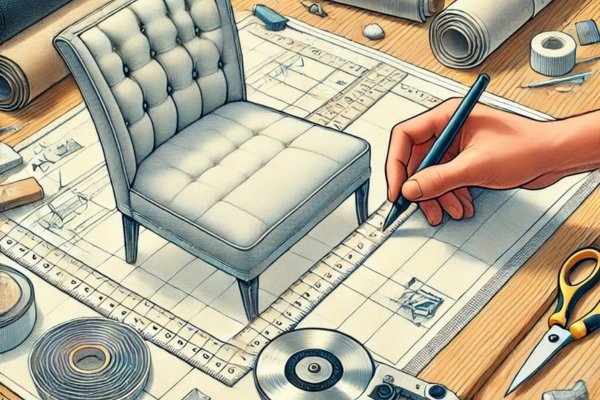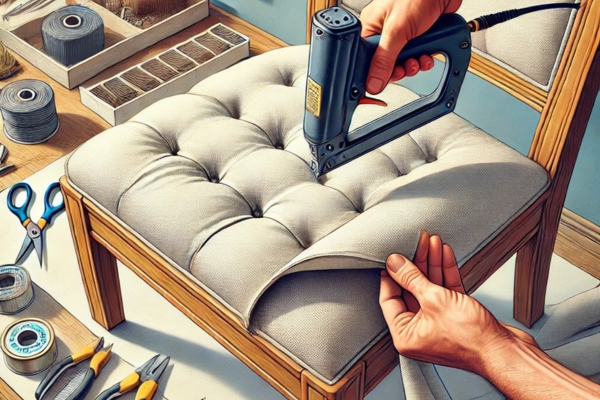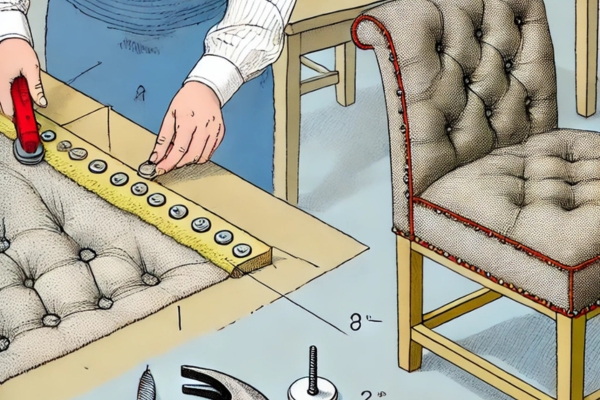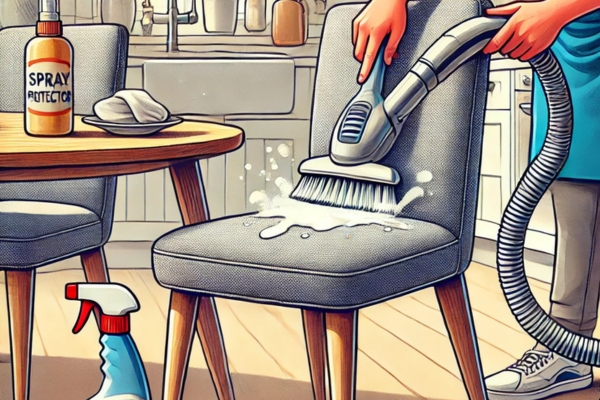Recover kitchen chairs, often a centerpiece of bustling kitchens, witness everything from celebratory feasts to hurried breakfasts. Over the years, their surfaces endure spills, stains, and general wear, leaving them less than inviting. Yet, rather than discarding these well-loved staples, recovering them offers a delightful opportunity to rejuvenate their charm. With a touch of effort and creativity, your tired chairs can become vibrant accents that elevate your space while saving you the cost of replacements.
Why Recovering Kitchen Chairs Can Transform Your Space?
Revitalizing your kitchen chairs isn’t just about aesthetics—it’s a profound transformation of your environment. Picture the shift: dull, faded seats replaced with fresh, eye-catching fabrics that match your vision. Whether aiming for modern minimalism or rustic warmth, the possibilities are boundless. Beyond their look, recovering chairs infuses personality into your home, showcasing your taste while inviting comfort and elegance into daily dining moments.
How To Clean Kitchen Chairs?
Before embarking on your recovery mission, Kitchen chairs cleaning is paramount. Old upholstery harbors dust and grime that can compromise your new design. Begin by vacuuming thoroughly to banish loose particles. Stubborn stains? A gentle detergent and soft cloth work wonders. Wooden frames need extra care—wipe with a damp cloth, ensuring to dry promptly to avoid water damage. For metal chairs, a quick soap-and-water rinse can restore their gleam. This meticulous preparation ensures a flawless starting point for your project.
The Benefits Of Refreshing Old Chairs Instead Of Buying New Ones
Why toss out when you can breathe life back in? Recovering chairs saves money—significantly so. Instead of splurging on new furniture, a few yards of fabric and basic tools deliver an affordable facelift. Beyond economics, there’s a satisfaction in sustainability. Each chair you recover is one less item in a landfill. And customization? It’s the ultimate perk. Tailor your chairs with fabrics, patterns, and designs unique to your space—choices mass-produced pieces seldom offer.
Who Can Recover Kitchen Chairs?
Think recovering chairs requires a professional touch? Think again. Armed with simple tools and a bit of guidance, anyone can master the craft. Beginners, take note: this project welcomes you with open arms. Its manageable scale and forgiving process make it ideal for first-time DIYers. No extensive skills are needed—just creativity and a willingness to experiment.
Understanding Chair Recovery Basics
At its core, chair recovery involves swapping old fabric for fresh, vibrant material. The process may seem daunting, but breaking it into steps simplifies the journey. Removal of the current upholstery reveals the underlying structure. Tools like staple guns and fabric shears become your allies, and with each action, the transformation feels increasingly tangible.
Choosing The Right Fabric For Your Kitchen Chairs
Fabric selection is where your chairs’ personality takes shape. Heavy-duty materials like microfiber or canvas withstand daily use, while velvets and jacquards exude luxury. Let the ambiance of your kitchen guide your choice—bold prints can energize, while muted tones foster calm. Families may lean toward stain-resistant options, ensuring longevity without sacrificing style.
Prepping Your Chairs For Recovery

Preparation separates amateur efforts from polished results. Detach the seat from the frame, exposing its true condition. Sand wooden frames for a smooth finish or touch up scratches with paint or varnish. Tighten screws and joints—secure frames ensure long-term durability. Measure dimensions meticulously to avoid fabric shortages or misalignment later.
Measuring For A Perfect Fit

Accuracy is everything. The wrong measurements can unravel the most carefully planned project. Measure each seat individually—dimensions can vary even in matching sets. Add a few inches to each side to allow for wrapping and securing. A steady hand and attention to detail during this step streamline the process that follows.
Cutting And Preparing Your Fabric

Lay your fabric on a flat surface, aligning it with your measurements. Use sharp scissors or a rotary cutter for precise edges, avoiding frayed seams. If adding padding, cut it to match the seat dimensions. Neat layering ensures a smooth, professional finish, making all the difference in the final appearance.
Securing The Fabric To The Chair

Here’s where transformation meets technique. Center the fabric on the seat and pull it taut, smoothing wrinkles as you go. A staple gun secures the edges, starting from one side and working toward the opposite. Corners require finesse—fold them tightly for a clean, polished look. Consistent tension prevents sagging over time.
Adding Decorative Touches

Elevate your recovered chairs with thoughtful embellishments. Nailhead trim lends a classic touch, while buttons or tufting add sophistication. Consider piping in contrasting colors for a tailored finish. These small details transform simple projects into bespoke creations that rival designer pieces.
Caring For Your Recovered Kitchen Chairs

Your hard work deserves preservation. Vacuum your chairs regularly, and treat spills swiftly with a damp cloth and mild cleaner. For fabrics prone to staining, a protective spray adds an extra layer of defense. Routine care not only keeps chairs looking pristine but also extends their life dramatically.
Common Challenges And How To Solve Them
Every project has its hiccups, but solutions abound. Wrinkles in fabric? Re-staple and smooth with increased tension. Struggling with torn edges? Reinforce with adhesive or double-layer the material. Loose staples? A staple remover and careful reapplication fix the problem in minutes. Perseverance and creativity ensure success.
Inspiration For Your Chair Recovery Project
Inspiration is everywhere—online platforms, interior design magazines, even local cafes. Rustic charm with burlap? Mid-century modern with geometric prints? The options are endless. Exploring trends can spark ideas that align perfectly with your vision.
Sustainability And Cost-Savings Of Recovering Chairs
By recovering instead of replacing, you champion eco-conscious choices. Each repurposed chair means less waste, fewer resources consumed, and a smaller carbon footprint. Financially, the savings are substantial, leaving you with more room to invest in other home projects or splurge on high-quality fabrics.
FAQs
How Long Does It Take To Recover Kitchen Chairs?
The time required to recover kitchen chairs largely depends on your experience level and the number of chairs involved. For beginners, it typically takes 1 to 2 hours to complete a single chair, as you’ll spend time measuring, cutting, and securing the fabric carefully. With practice, the process becomes quicker, and an entire set can be recovered in a single afternoon. Having all your tools and materials prepared beforehand can significantly reduce the overall time.
Can I Recover Non-Upholstered Chairs?
Yes, non-upholstered chairs can be recovered or upgraded with some creative approaches. For wooden or metal chairs, you can add detachable cushions covered in your chosen fabric or even use adhesive-backed fabric for a more integrated look. These alternatives mimic the effect of traditional upholstery while allowing you to customize the design. Cushions with ties or Velcro fasteners are particularly handy for families or spaces where flexibility is key.
What’s The Best Fabric For A Busy Household?
In households with high activity, durability and ease of cleaning are top priorities. Fabrics like microfiber, canvas, or synthetic blends are excellent choices due to their resistance to stains and wear. Vinyl or faux leather is also a practical option, as they can be wiped clean with a damp cloth, making them ideal for homes with children or pets. Opt for darker shades or patterns that can camouflage minor stains while maintaining a stylish appearance.
Conclusion
Recovering kitchen chairs isn’t merely a task—it’s an artistic endeavor that rejuvenates your living space. Combining affordability, sustainability, and limitless creative potential, it’s a project worth pursuing. Armed with knowledge and inspiration, take that first step toward transforming the familiar into the extraordinary.
